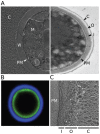Peeling the onion: the outer layers of Cryptococcus neoformans
- PMID: 29742198
- PMCID: PMC5951675
- DOI: 10.1590/0074-02760180040
Peeling the onion: the outer layers of Cryptococcus neoformans
Abstract
Cryptococcus neoformans is an opportunistic fungal pathogen that is ubiquitous in the environment. It causes a deadly meningitis that is responsible for over 180,000 deaths worldwide each year, including 15% of all AIDS-related deaths. The high mortality rates for this infection, even with treatment, suggest a need for improved therapy. Unique characteristics of C. neoformans may suggest directions for drug discovery. These include features of three structures that surround the cell: the plasma membrane, the cell wall around it, and the outermost polysaccharide capsule. We review current knowledge of the fundamental biology of these fascinating structures and highlight open questions in the field, with the goal of stimulating further investigation that will advance basic knowledge and human health.
Figures

References
-
- Agustinho DP, Nosanchuk JD. Functions of fungal melanins. In: Reference module in life sciences. 2017. Available from: http://www.sciencedirect.com/science/article/pii/B9780128096338120916.
Publication types
MeSH terms
Substances
Grants and funding
LinkOut - more resources
Full Text Sources
Other Literature Sources

